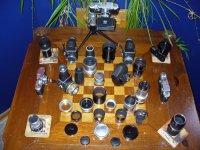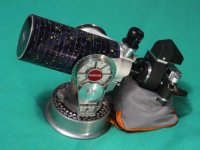eli griggs
Well-known
Looking at the Visoflex in the classifieds, I was wondering, how well did/do these work and what sort of range of lenses were available for them? Do they offer any advantage over a slr, beyond adding another dimension to an otherwise great camera line?
Eli
Eli
JNewell
Leica M Recidivist
I used them for years for (1) close-ups and (2) teles > 135mm. My favorite setup was the slide-focus 400/6.8. On the slow side, but light, fast and exceptionally sharp images.
How do they work...they work very well, but in general more slowly than an SLR, and metering through the lens, although possible, makes the whole process even slower. For close-up work, this isn't a big factor. For tele lenses, it's ok as long as the light's not too tricky. Bear in mind that pointing a reflected light meter downrange and metering, say, 30-45 degrees of the scene will, under some circumstances, produce a reading that's not representative of what your 400mm lens, with its very selective field of view, will be capturing. Having said all that, I used it mostly on an M3 and an M4-P and I got along very well indeed.
Lenses...you could mount special macro lenses, as well as 35mm and 50mm RF lenses - only for closeup work, they wouldn't focus to infinity because of the thickness of the Viso mirror housing.
There was a 65mm f/3.5 that was a great lens and would mount in an accessory focusing mount and would focus to infinity.
There were also accessory focusing mounts for 90mm and 135mm lenses that would allow infinity focus, but the tele system came into its own with dedicated tele lenses of 200, 280, 400 and 560mm (in the more recent versions; there were other focal lengths in earlier production). The 400 and 560 were optical twins of their R equivalents and were (still are) exceptional lenses.
The range of bits and pieces that supported this system is incredible (in number and diversity). However, unless you really want to experience it, or unless you get such a charge out of using these beautifullyl engineered pieces, you're way ahead buying a good SLR and the proper macro lens. (OK, I will stand still now while you all throw things at me.)
How do they work...they work very well, but in general more slowly than an SLR, and metering through the lens, although possible, makes the whole process even slower. For close-up work, this isn't a big factor. For tele lenses, it's ok as long as the light's not too tricky. Bear in mind that pointing a reflected light meter downrange and metering, say, 30-45 degrees of the scene will, under some circumstances, produce a reading that's not representative of what your 400mm lens, with its very selective field of view, will be capturing. Having said all that, I used it mostly on an M3 and an M4-P and I got along very well indeed.
Lenses...you could mount special macro lenses, as well as 35mm and 50mm RF lenses - only for closeup work, they wouldn't focus to infinity because of the thickness of the Viso mirror housing.
There was a 65mm f/3.5 that was a great lens and would mount in an accessory focusing mount and would focus to infinity.
There were also accessory focusing mounts for 90mm and 135mm lenses that would allow infinity focus, but the tele system came into its own with dedicated tele lenses of 200, 280, 400 and 560mm (in the more recent versions; there were other focal lengths in earlier production). The 400 and 560 were optical twins of their R equivalents and were (still are) exceptional lenses.
The range of bits and pieces that supported this system is incredible (in number and diversity). However, unless you really want to experience it, or unless you get such a charge out of using these beautifullyl engineered pieces, you're way ahead buying a good SLR and the proper macro lens. (OK, I will stand still now while you all throw things at me.)
Glenn2
Well-known
You're not limited to Leica glass with a Visoflex. Almost anything can be made to work with cobbled together adaptors. Have used enlarger lenses for close-ups which worked very well. For extreme telephoto, the skies the limit... ;-)
The attached photo shows M4 + Visoflex connected to a 3.5" Questar telescope for an efective focal length of 1400mm.
The attached photo shows M4 + Visoflex connected to a 3.5" Questar telescope for an efective focal length of 1400mm.
Glenn2
Well-known
dlove5
Established
The visoflex system is slow, clunky and has no real advantages over SLRs. I think you have to be a masochist or a real gearhead to want to use it.
Oh.....
I do have fun using my visoflex stuff.
There are times when I don't want to carry around an SLR and telephoto in addition to my rangefinder stuff when I know I will only be using the telephoto for a few shots. In that case, the visoflex saves some weight and space.
There are a lot of bits and pieces. Between different mirror housings, prisms, focusing mounts and extension rings; I think have around 25 bits and pieces.
Here are most but not all of my Visoflex related bits and pieces along with my IIIa, IIIg, IIIf and other pieces.

Oh.....
I do have fun using my visoflex stuff.
There are times when I don't want to carry around an SLR and telephoto in addition to my rangefinder stuff when I know I will only be using the telephoto for a few shots. In that case, the visoflex saves some weight and space.
There are a lot of bits and pieces. Between different mirror housings, prisms, focusing mounts and extension rings; I think have around 25 bits and pieces.
Here are most but not all of my Visoflex related bits and pieces along with my IIIa, IIIg, IIIf and other pieces.

x-ray
Veteran
I used the viso II and 65, 90 and 200 for about 15 years. Sorry but no way would I ever use one again. I tried the Viso II and disliked it more then the II. Super slow at best, heavy, dim and coarse screne and large. The leica glass for it isn't anything special by todays standards either. It's stone age technology and optical design. I saw the one for sale here and looked at the price thinking I wouldn't give $100 for the set. No reflection on the person selling it but it's not worth much in todays world other than a relic of the past. $600 will buy you a fantastic SLR and 200 that will stomp the old tellyt and viso II. Basically all of the lenses above 135mm for the M's are old old designs with only marginal performance compared to the new Nikon ED or Canon L long glass.
eli griggs
Well-known
This is just to sort of stuff that makes Leica so fascinating. When I look at all the add-ons and cool innovations to these cameras, I can not but think of some fantastic collection of secret decoder rings. The fact that so many have equally weird names and require an intimate knowledge of what goes with what, just makes Leica so much more interesting.
When I was younger, I use to wonder what the attraction to Leica 'collecting' was; now I know.
By-the-way, did any of the famous Leica photographers use the Visoflex as a main tool, sort of a signature?
Eli
When I was younger, I use to wonder what the attraction to Leica 'collecting' was; now I know.
By-the-way, did any of the famous Leica photographers use the Visoflex as a main tool, sort of a signature?
Eli
Roger Hicks
Veteran
Smaller, lighter and cheaper than carrying two more reflex bodies (one colour, one mono) plus appropriate lenses. Yes, the glass is geriatric, but I'm seriously considering replacing my old 200, 280 and possibly 400 Leica lenses, sold years ago: the only lens I use at present is the 65/3,5. Quality? Publishable: I've had Viso shots published in enough books that I suspect that Viso lenses are no significant barrier.
Cheers,
Roger
Cheers,
Roger
Last edited:
Tom A
RFF Sponsor
The Visoflex system is the ultimate for gadget freaks. I have had them for decades - currently only a II and a III, but there are odd adapters, rings, extension tubes etc all over my desks! They work well, slow and a bit "plodding" - but if you can fit it in the throat of the Viso, you most likely can take pictures with it!
For extreme macro work - add a set of Bellows II and think "reciprocity" ( boy are going to wish you had stayed awake during math classes in school). A good enlarging lens, a couple of extension tubes added to the bellows and you can do reflections in the proverbial gnat's eye!.
The advantage with the Viso is that it is reasonably cheap and if you are lucky and find a 65/3.5 Elmar, you can do great work with it - it will focus to infinity too.
For extreme macro work - add a set of Bellows II and think "reciprocity" ( boy are going to wish you had stayed awake during math classes in school). A good enlarging lens, a couple of extension tubes added to the bellows and you can do reflections in the proverbial gnat's eye!.
The advantage with the Viso is that it is reasonably cheap and if you are lucky and find a 65/3.5 Elmar, you can do great work with it - it will focus to infinity too.
SteveM(PA)
Poser
Here are a few of my Visoflex 1 pictures:
http://www.rangefinderforum.com/photopost/showgallery.php?cat=7181
http://www.rangefinderforum.com/photopost/showgallery.php?cat=7181
eli griggs
Well-known
Nice stuff SteveM, especially the guitar shot. Thanks for sharing!
Eli
Eli
Ronald M
Veteran
Google for "visoflex pages" It is a site devoted to viso. Everything is there.
The hard part is finding all the adapters, extension tubes, bellows, and focus mounts. It was hard in 1980 when I managed to get everything, very difficult now.
The advantage is there is no vibration from a mirror and the pictures are very sharp.
A black 65 Elmar is a great lens for it. Chrome is so so but still Leica.
Add a 90 2.8 Elmarit, 135 4.0 tele elmar and you will be in 1980 heaven.
The hard part is finding all the adapters, extension tubes, bellows, and focus mounts. It was hard in 1980 when I managed to get everything, very difficult now.
The advantage is there is no vibration from a mirror and the pictures are very sharp.
A black 65 Elmar is a great lens for it. Chrome is so so but still Leica.
Add a 90 2.8 Elmarit, 135 4.0 tele elmar and you will be in 1980 heaven.
Dralowid
Michael
I still have a Viso III and use it on an M6 occasionally BUT I bought a black Leicaflex SL and the appropriate adaptor and the Viso is now virtually unused. However Telyts are great as is the 65mm lens.
Michael
Michael
Share:
-
This site uses cookies to help personalise content, tailor your experience and to keep you logged in if you register.
By continuing to use this site, you are consenting to our use of cookies.

